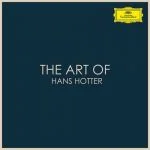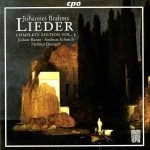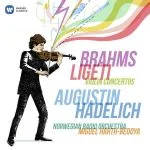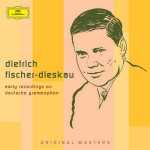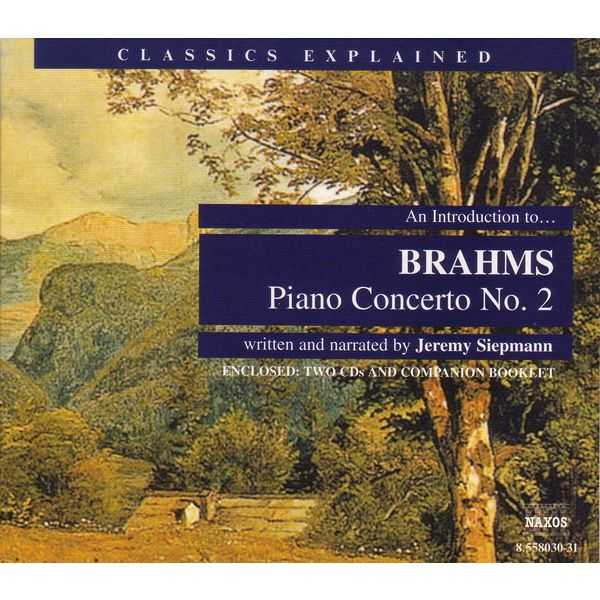
Composer: Johannes Brahms
Performer: Jeremy Siepman
Number of Discs: 2
Format: FLAC (tracks)
Label: Naxos
Catalogue: 8558030-31
Release: 2001
Size: 408 MB
Recovery: +3%
Scan: yes
CD 01
01. Introduction; opening horn call and piano’s answer
02. Rising three-note scalewise pattern
03. Quicker, descending six-note ‘answer’
04. Second, answering phrase
05. First Main Theme completed by orchestra
06. Peace shattered as piano bursts back in like a tiger
07. Variant of opening horn call in bass
08. Orchestra returns; beginning of Exposition proper
09. Big, ‘singing’ theme in orchestra; piano ‘forgotten’
10. Call to arms by strings; marshalling of orchestral forces
11. Piano re-enters fry with massive expansion of opening figure
12. Piano ‘explores’ two main facets of opening theme
13. Transition. sense of key weakened. Piano and orchestra come together
14. Piano and orchestra ‘argue’ over speed of thematic three-note rise
15. Piano and orchestra in friendly dialogue before piano falls away
16. ‘Winged’ harmonic shadow of pure pianistic tone-colour
17. New ‘transitional’ theme from orchestra developed by piano
18. After indecision and discussion, the mood suddenly turns playful
19. Reminder of Second Main Theme in its original form
20. Ttransfomation of Second Main Theme by piano
21. Piano hijacks orchestra’s ‘call to arms’
22. Piano and orchestra, now allies, explore theme, but with piano leading
23. Dramatic eruption of orchestra leads to the Development section
24. Pianistic ‘tiger’ replaced by gentle reflective, soft-spoken poet
25. Transformed ‘tiger’ theme amicably shared by piano and orchestra
26. An apparently new theme – but Battlle Hymn of the Republic?
27. Brief, downward-driving section prepares for the Recapitulation
28. On the threshold of the Recapitulation
29. Recapitulation: The Magical Return
30. From Gate-crashing Tiger to Celestial Tenderness – and a surprise
31. And unexpected and portentus change of mood, suggesting tragedy
32. Summation
33. First Movement (Complete)
34. Second Movement: The upward-driving opening gambit, piano alone
35. Downward-driving answer from lower strings
36. Theme vs Melody
37. Eerie, unharmonised, ‘white’ sound of Second Theme
38. Second Theme taken up and developed by piano
39. Expectation and surprise; harmonic fluidity and intensifying drama
40. Return (and transformation) of Theme Two
41. Theme One returns in orchestra; Theme Three emerges in major mode
42. Sequence of fragmentary episodes begins with unexpected fanfare
43. Variant of Theme Three in piano
44. Rescored variant of ‘fanfare’ theme; from grandeur to solemnity
45. Rhapsodic variant of fanfare, this time for piano alone
46. Recapitulation of opening, with piano and orchestra reversing roles
47. Theme Two transformed by new instrumentation
48. Cue and Second Movement (Complete)
CD 02
01. Introduction, cue and First Main Theme
02. Theme One taken up by strings and solo oboe; piano’s entry
03. Complex variant of Theme One with very different speed and rhythm
04. Orchestra and piano in mixed variants of Theme One, now intensified
05. Theme Two, hushed and ‘tuneless’, with piano, clarinets and strings
06. Oboe Theme returns, now delicately embroidered by the piano
07. Cue and Third Movement (Complete)
08. Finale: Introduction, cue and Main Theme
09. Violins take up tune, with winds and piano accompanying
10. Piano introduces Part 2 of the main theme
11. Part 3 of the theme, led by piano, in ‘fiercely’ self-confident mood
12. First Episode, Part 1
13. First Episode, Part 2
14. Piano hands theme over to clarinets and bassoons
15. First Episode, Part 3, in piano, first; then flutes and oboes
16. Strings and flutes take theme, with bubbling commentary from piano
17. Tipsy dancers (piano and winds) return, tiring; strings take over
18. In the central Episode, the orchestra throws down a dramatic challenge
19. … to which the piano duly responds with a stormy outburst
20. Piano kick-starts run-up to final section in a variant of the main theme
21. Orchestra sets off on jaunty march, later joined by the piano
22. Piano propels orchestra into final section
23. Summation and cue to the movement as a whole
24. Finale (Complete)
